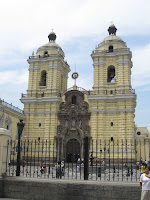Arequipa is known as the "White City" due to the copious amounts of white volcanic rock used in the construction of the city´s buildings. It also doesn´t have lots of high buildings due to earthquakes, a bit like Napier really. A big difference is that Arequipa is surrounded by three big volcanoes, Picchu Picchu, Misti and Chanchani.
The first tourist site we hit was the museum dedicated to a Incan mummy found on one of the many volcanoes in the Arequipa region (in addition to the three named above). The scientist that found her body named her "Juanita". Unfortunately the lovely dessicated girl wasn´t on show between January and April, so we saw another mummy named "Serita". She was a rare Incan sacrifice (they weren´t really into it, unlike the central American Mayans) to most probably appease Inti (the Incan Sun God) following a big eruption or earthquake. The girl was raised for the express purpose and was probably about 14 or 15 at her death. She followed the shamans up the mountain where she got wasted on chicha, a local maize booze, and then a swift blow to the left temple finished the job. Afterwards the body was placed in a tomb on the mountain and a stone circle placed around the top to mark the grave. It was an honour for her as it meant she was close to the gods and could speak to them on behalf of her people. Incans didn´t practice human sacrifice as a matter of course, although there have been about a dozen of these mummies uncovered on the local volcanoes.
The afternoon in Arequipa was failry chilled out, and after an unfortunately big night on mojitos it meant that the trip to Colca Canyon the next day for our condor spotting excursion was unbearable. But that´s a story for another day.

























